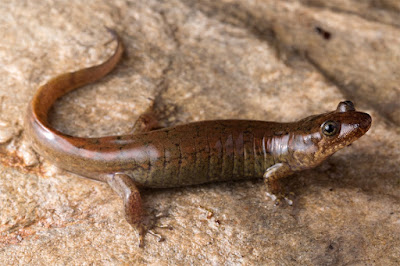 |
| Desmognathus spp. in Pyron & Beamer, 2022. |
Abstract
To be available under the International Code of Zoological Nomenclature, nomina erected after 1930 must “be accompanied by a description or definition that states in words characters that are purported to differentiate the taxon” (Article 13.1.1). For many so-called ‘cryptic’ species, this may prove difficult when relying on external morphology. Yet, such species are likely to be diagnosable by (fixed or variable) differences in DNA sequences, which can also be treated as characters and described in words. While recent authors have proposed such methods, they have rarely been adopted as the primary diagnostic implement in vertebrates. Additionally, morphometrics may reveal subtle but distinct variation in size and shape, which may not be dispositive for identifying individual specimens but can nonetheless characterize overall differences between species. We employ these techniques here to revise the taxonomy of the Black-bellied Salamanders Desmognathus folkertsi and Desmognathus ‘quadramaculatus’ from the southern Appalachian Mountains of the eastern United States. While the former was diagnosed by a variety of morphological and molecular characters, the latter was poorly characterized and subsequently found to consist of two distantly related clades of six genetic lineages. Recent nomenclatural work found that the nomen Salamandra quadramaculata Holbrook, 1840 was unavailable for this species and that no valid nomen had ever been applied at the species level. We erect three new species and resurrect one junior synonym to account for species-level geographic genetic variation in the group. All nomina are diagnosed with explicit reference to fixed or varying allelic differences at mitochondrial and nuclear loci, quantitative variation in overall size and shape from linear morphometrics, and qualitative description of color-pattern variation. Despite their gross similarity, we hypothesize that subtle, as-yet undetected phenotypic variation exists between these species, which may be revealed by geometric morphometrics, 3D scanning, and other data such as physiology and behavior. We also utilize recently developed technologies to present DNA-sequence data for these species in a compact, reproducible format to permanently associate the observed characters with the original description, with several thousand base pairs taking up only a few cm2. These approaches may prove useful for future descriptions of amphibians with highly similar external phenotypes.
Keywords: validity, molecular characters, availability, convergence, phenotype, Amphibia
 |
| Cherokee Black-bellied Salamander Desmognathus gvnigeusgwotli in life, from Straight Fork, Great Smoky Mountains, North Carolina (Photo: Todd Pierson, Kennesaw State University) |
 |
| Desmognathus kanawha from Whitetop, Virginia (Photo: Todd Pierson, Kennesaw State University) |
 |
| Desmognathus mavrokoilius from Hickory Creek on Bearwallow Mountain, North Carolina (Photo: Max Seldes, University of Georgia) |
R. Alexander Pyron and David A. Beamer. 2022. Nomenclatural Solutions for Diagnosing ‘Cryptic’ Species using Molecular and Morphological Data facilitate A Taxonomic Revision of the Black-bellied Salamanders (Urodela, Desmognathus ‘quadramaculatus’) from the southern Appalachian Mountains. Bionomina. 27(1); 1-43. DOI: 10.11646/bionomina.27.1.1

